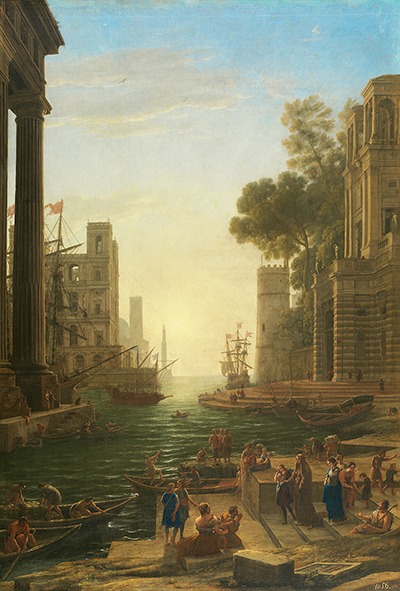This delightful artwork was constructed by Claude Lorrain in around 1639–1640. It features a heavy concentration of architecture on both sides of the composition, as well as many other features typical of the artist.
Landscape with St Paula of Rome Embarking at Ostia can now be found in the Prado Museum in Madrid, Spain and sits alongside a number of other Claude paintings within an impressive permanent collection. Philip IV of Spain would commission a large project for the artist which included a number of portrait and landscape shaped pieces. This explains why they now reside within Spain today, as most of the rest of the artist's career is today spread between Italy, France and the UK. A few other artworks have also made it as far as the US. Philip IV planned to host a gallery of landscape art within the Palacio del Buen Retiro and targeted Claude for a large series of works which would help to fill it. At the time, his reputation was strong across Italy and was starting to spread into neighbouring countries, though at the time the European map was much more fractured than it is today. The overall series was tackled by the artist during the period of 1635-1638 and it is likely that his work on each painting would have overlapped from one to the next.
The composition will remind many of Embarkation of the Queen of Sheba, as we have a fairly concentrated display of architecture rather than the artist's normal focus on nature. This vertical shape is ideally suited to the tall classic structures that line the two flanks of this design, whilst the perspective slowly leads forwards towards a bright central point on the horizon. Many ships are dotted around to aid the feeling of perspective, whilst a large number of figures in the foreground are spread across the harbour.St Paula was an ancient Roman saint and also known as early Desert Mother. She was around in the 4th century and Claude himself lived much of his life in the city of Rome and so became highly knowledgeable on the city's history, architecture and culture.
The King of Spain would also call upon the services of Gaspard Dughet, Jan Both, Herman van Swanevelt, Nicolas Poussin and Jean Lemaire to fill the rest of his landscape gallery. These represent slightly different styles and nations, suggesting that the King had a love for landscape art, but also a varied interest in how it could be delivered. Many of the royal-owned or commissioned artworks from that period within Spain would remain on display within their properties for many years before later being switched to public galleries to allow the people of Spain to also see them in person. Most of these venues would also be located in major city centres, ensuring as many people as possible would be able to view some of these stunning artworks. The Prado itself was one of the beneficiaries of this, and remains one of the finest art galleries in the world.




